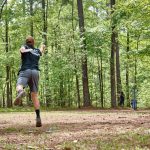A Hazy Beginning
The early days of disc golf were marked by experimentation, innovation, and a dash of chaos. The first recorded game was played in 1964 by Ed Headrick, a.k.a. the “Father of Disc Golf,” in La Cañada Flintridge, California. Headrick, a Frisbee enthusiast and inventor, created a makeshift course using natural obstacles and constructed baskets from tree branches and old tires.
The First Major Obstacle
The initial challenge disc golf faced was finding courses to play on. Back then, most parks were designed for traditional golf and didn’t allow frisbees. Headrick and his friends had to get creative, using fields, parks, and even abandoned golf courses to find suitable terrain. This era of pioneering spirit and flexibility laid the groundwork for what would become a global sport.
The Role of Ed Headrick
Ed Headrick played a crucial part in shaping the early days of disc golf. An inventor, entrepreneur, and passionate advocate, he tirelessly promoted the sport, inventing new equipment, course designs, and rules to govern play. His unwavering dedication earned him the nickname “The Lord of the Frisbee.” Headrick’s iconic designs, such as the “Putter” and “Driver,” remain classics in the disc golf community.
The Dawn of Competition
The first official tournament took place in 1976 at the La Cañada Flintridge course, with 36 players participating. The pioneering spirit continued to grow as more events emerged, pitting the best players against each other. The Golden State, California, particularly, became a hotbed for competition, hosting state and national championships.
A New Era Awaits
The 1980s and 1990s marked a significant turning point in disc golf’s development. The Professional Disc Golf Association (PDGA) formed in 1976 to govern the sport, provide a framework for competition, and establish standards for equipment and courses. This created a foundation for growth and recognition.
Rise to Prominence
From the early days of hazy beginnings to the golden era of growth, disc golf has continued to mature. Modern courses feature strategically designed obstacles, precision- crafted baskets, and finely tuned rules. The number of players has increased tenfold, with over a million enthusiasts worldwide.
The Modern Disc Golfer
Today’s disc golfer is a testament to perseverance and passion. With dedicated courses in over 25 countries, the sport attracts a diverse range of athletes, from casual enthusiasts to professional players. The world’s top-ranked players like Paul McBeth, Nate Sexton, and Catrina Allen have become legends in the sport.
The Impact of Professional Disc Golf
The rise of professional disc golf has brought an influx of attention and investments. Sponsors, organizers, and media outlets take notice of the sport, recognizing its unique blend of athleticism, strategy, and camaraderie. Local and national events draw increasing crowds, fostering a stronger sense of community.
The Future of Disc Golf
As the sport continues to evolve, disc golf may soon join the ranks of mainstream sports. With recent additions to the Olympic sports program and growing popularity at the collegiate level, opportunities for growth and recognition emerge. New technologies, training methods, and innovative training facilities further solidify its position.
The Legacy of Disc Golf Pioneers
Ed Headrick, the “Father of Disc Golf,” and other visionary pioneers laid the groundwork for the sport we know and love today. Their persistence, creativity, and shared passion for flight have set the stage for a promising future. As the global disc golf community continues to grow, we honor these trailblazers and continue to build upon their tireless efforts.
The early days of disc golf were marked by experimentation, innovation, and perseverance. From humble beginnings to a global phenomenon, the sport has come a long way. As it continues to evolve, so too does its impact. With its unique blend of athleticism, strategy, and camaraderie, disc golf is poised to maintain its position as a staple in the world of sport.
Q: What is the origin of disc golf?
A: The first recorded game of disc golf was played in 1964 by Ed Headrick in La Cañada Flintridge, California.
Q: Who is the founder of disc golf?
A: Ed Headrick, also known as the “Father of Disc Golf,” is often credited with inventing and popularizing the sport.
Q: What is the Professional Disc Golf Association (PDGA)?
A: The PDGA is the governing body of disc golf, responsible for establishing rules, standards for equipment and courses, and hosting competitions.
Q: How popular is disc golf today?
A: With over a million players worldwide, disc golf is a rapidly growing sport.
Q: Is disc golf recognized at the Olympic level?
A: Not yet, but with growing popularity and recent additions to the Olympic sports program, it may soon join the ranks of mainstream sports.
Q: What is the most recognized professional disc golfer?
A: Paul McBeth is a highly decorated professional disc golfer and one of the most recognizable names in the sport.








